This article was originally published on the web on livingbonsai.com however that website is defunct at June 2012. The copyright is with the original owners of livingbonsai.com
Styles of Bonsai
 Broom (Hokidachi). Straight trunk with the branches arranged in a semi-circular dome. Classic Bonsai style associated with trees unexposed to the more violent effects of nature.
Broom (Hokidachi). Straight trunk with the branches arranged in a semi-circular dome. Classic Bonsai style associated with trees unexposed to the more violent effects of nature.
 Cascade-full (Kengai). Where the branches and trunk of a Bonsai tree are swept to one side and hang below the roots. Simulates tree on the edge of a cliff subjected to violent winds.
Cascade-full (Kengai). Where the branches and trunk of a Bonsai tree are swept to one side and hang below the roots. Simulates tree on the edge of a cliff subjected to violent winds.
 Cascade-semi (Han-Kengai). A bonsai where the branches and trunk of a tree are swept to one side but not fully weeping. Simulates a tree subject to violent winds.
Cascade-semi (Han-Kengai). A bonsai where the branches and trunk of a tree are swept to one side but not fully weeping. Simulates a tree subject to violent winds.
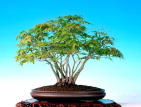 Clump (Kadudachi). More crowded in appearance than a group/forest planting of Bonsai as the trunks all grow from the same point on the root mass.
Clump (Kadudachi). More crowded in appearance than a group/forest planting of Bonsai as the trunks all grow from the same point on the root mass.
 Formal upright (Chokkan). A bonsai with straight and upright trunk with the branches forming a balanced style, usually with an overall triangular form.
Formal upright (Chokkan). A bonsai with straight and upright trunk with the branches forming a balanced style, usually with an overall triangular form.
 Group / Forest (Yose-ue). Bonsai are arranged in a container to resemble a forest of trees.
Group / Forest (Yose-ue). Bonsai are arranged in a container to resemble a forest of trees.
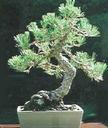 Informal upright (Moyogi). Trunk curves and twists through its taper up to and through the branches. The branches form a balanced Bonsai style, usually with an overall triangular form.
Informal upright (Moyogi). Trunk curves and twists through its taper up to and through the branches. The branches form a balanced Bonsai style, usually with an overall triangular form.
 Literati (Bunjingi). This Bonsai is were the tree has around two thirds of its trunk without any branches illustrating age and maturity.
Literati (Bunjingi). This Bonsai is were the tree has around two thirds of its trunk without any branches illustrating age and maturity.
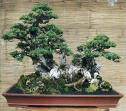 Raft (Ikadabuki). The Bonsai tree is laid on its side and the branches are arranged in a group formation trained vertically.
Raft (Ikadabuki). The Bonsai tree is laid on its side and the branches are arranged in a group formation trained vertically.
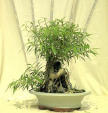 Root over rock (Sekijoju). A Bonsai tree which has roots arranged so they grow over the rock and into the container.
Root over rock (Sekijoju). A Bonsai tree which has roots arranged so they grow over the rock and into the container.
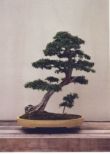 Slanting (Shakan). Similar to the formal upright Bonsai style but with the trunk slanting to one side simulating its reaction to the wind or as it searches out light.
Slanting (Shakan). Similar to the formal upright Bonsai style but with the trunk slanting to one side simulating its reaction to the wind or as it searches out light.
 Twin trunk (Sojo). Bonsai has two trunks which are joined at the base of the tree.
Twin trunk (Sojo). Bonsai has two trunks which are joined at the base of the tree.
 Windswept (Fukinagashi). Trunk and branches swept back in one direction illustrating a tree exposed to violent winds.
Windswept (Fukinagashi). Trunk and branches swept back in one direction illustrating a tree exposed to violent winds.